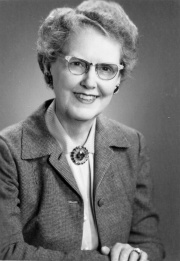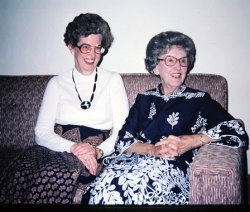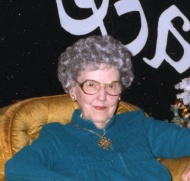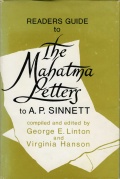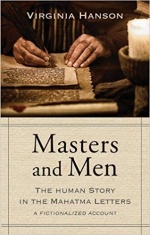Virginia Hanson
Virginia Gordon Hanson was an editor and writer best known for her books Masters and Men and, with George Linton, the Readers Guide to The Mahatma Letters to A. P. Sinnett.
Personal life and career
Virginia Gordon was born in Illinois on October 27, 1898 to attorney James Walker Gordon (1867-1940) and his wife Mary Hickok Gordon (1867-1910). They had four children – Bessie, Kenneth, Paul, and Virginia. The family lived in Oquawka, Illinois, on the Mississippi River. James was a state's attorney, then judge, and was active in the Presbyterian church and in Masonic organizations. Virginia attended college for one year, and married Harold E. Hanson (1897-1972), also of Oquawka. They moved to New York, and had a son, Jame Edward Hanson, on December 11, 1927. By 1940 the family had moved to Silver Spring, Maryland, where Harold worked as a salesman and Virginia as a secretary.
Theosophical work
Mrs. Hanson joined the Theosophical Society in America on October 12, 1949,[1] in Washington, D. C, where she worked as a government employee for 25 years, as editor of publications at the Federal Bureau of Prisons in the U. S. Department of Justice. While working in Washington, she was active in the Washington Theosophical Society, serving as president for several years, and also served as president of the Mid-Atlantic Federation.[2] She was equally active at the national level, becoming a prominent lecturer for the Society and a prolific writer on many subjects. During the 1950s, for example, she traveled at least six times each year to Baltimore to lecture at the Maryland Lodge, while also serving on the editorial board for The American Theosophist.
After retiring in 1962, Mrs. Hanson joined the headquarters staff, where she stayed for 13 years. Among her responsibilities was editing The American Theosophist.[3] She also became Senior Editor of Quest Books of the Theosophical Publishing House (Wheaton) in 1973, following the sudden death of Helen Zahara, and took on the chairmanship of the Department of Education.[4][5] She also wrote a series of educational letters that were sent to new members, a practice that continues to this day.
William Quinn, her successor as editor of The American Theosophist wrote this "encomium" for Virginia Hanson:
Few people, I think, really understand what editorial work entails, and fewer still know of the professional, superior and extensive work which Mrs. Hanson did as an editor for The Theosophical Society - as both Senior Editor for The Theosophical Publishing House and as Editor of this journal. She established, as Editor of The American Theosophist, not only the highest quality standards for material published, but began the very successful Special Issues, which appear twice a year. Her work in accelerating the Quest Book series of The Theosophical Publishing House into "adulthood" was invaluable - no descriptive adjective can adequately express the superlative quality and prodigious amount of "over-work" which she did for the TPH publishing program.
But an encomium for Virginia Hanson cannot be limited simply to editorial ability, nor can her work be separated from her humanness. No Assistant Editor - in fact, no one - could have had a finer person with which to work, or to teach and instruct him. Like Midas's touch, every difficulty or problem she encountered turned to resolution and harmony, and every person she dealt with testifies to her warmth, understanding, and compassion. Her decisions always reflected wisdom, and the fact that they had been made by a real theosophist. No gentler or more beautiful a person exists, in my admittedly biased opinion. [6]
Daniel Caldwell's 1991 book The Occult World of Madame Blavatsky was dedicated to Miss Hanson. The author wrote, "Virginia always gave me encouragement in my Theosophical studies."[7]
Readers Guide to the Mahatma Letters
Mrs. Hanson wrote to Walter A. Carrithers, Jr. about her interest in the Mahatma Letters:
I have long been rather an avid student of the Letters and have been repeatedly baffled, and even appalled, to hear people say "I just can't read them," or "They are just a jumbled lot of letters that don't make sense," and especially, "I can't tell what is going on."
For a number of years, when I was on the staff at the headquarters of the Theosophical Society in America at Wheaton, Illinois, I was a member of a small group which met weekly to read and discuss the Letters. During that time I came to realize what a fascinating story ran through them -- a story rich in both human and occult interest. One evening it suddenly occurred to me that it would be an exciting challenge to try to tell that story, using the Letters themselves as -- I suppose one might say the stage, and the many unusual and interesting persons who move in and out of the story as the actors. The analogy is quite loose, but it gives a hint. I was, quite frankly, startled and rather aghast at myself for having such a brash idea and rather put it aside, thinking, "I am not the one to do it."
Later, after I came to Krotona to live, I conducted a course in the study of the Letters at the Krotona School of Theosophy during 1976-78.... Based on my experience with the class, I began to feel that the story had to be told and that, since I had done so much work and accumulated such voluminous notes, perhaps I was, after all, the one who had to tdo it. My hope is that, if and when published, the book may lead to a more serious study of all that is involved in the Letters themselves.[8]
George Linton and his wife, of Portland, Oregon, frequently visited the TSA headquarters while Mrs. Hanson was there. George and Virginia collaborated in writing the Readers Guide to The Mahatma Letters to A. P. Sinnett, which was the product of much study by each of the coauthors. It continues to be a valuable tool for study of the letters.
Later years
From 1975 until her death on May 27, 1991, Mrs. Hanson was on the staff of the Krotona Institute of Theosophy, as a corresponding secretary for the Esoteric Section. She taught classes on The Mahatma Letters to A. P. Sinnett at the Krotona School of Theosophy. Joy Mills was a close friend and colleague.[9]
Awards
The Olcott Foundation named Virginia Hanson to win its lecture award for 1951, in recognition of her lecture, "The Divine Autobiography - A Universal Best Seller."[10] In 1990, Mrs. Hanson was awarded the prestigious Subba Row Medal for her Theosophical writings.[11][12]
Mrs. Hanson left a 500-volume library to the Krotona School of Theosophy, and the Virginia Hanson Memorial Library was named in her honor.[13]
Writings
In addition to her educational letters and the Readers Guide, Mrs. Hanson made many other contributions to Theosophical literature. These books are listed in chronological sequence:
- H. P. Blavatsky and The Secret Doctrine: Commentaries on Her Contributions to World Thought. Wheaton, IL: Theosophical Publishing House, 1971. It is a collection of essays originally published in The American Theosophist, in May 1969, with five additional essays. A second edition came out in 1988.
- Approaches to Meditation. Wheaton, IL: Theosophical Publishing House, 1973. Published in Finnish in 2002.
- Gifts of the Lotus: a Book of Daily Meditations. Wheaton, IL: Theosophical Publishing House, 1974.
- The Silent Encounter: Reflections on Mysticism. Wheaton, IL: Theosophical Publishing House, 1974. Manly P. Hall contributed a chapter.
- The Mahatma Letters: Today's Encounter with the Wisdom of the Ages. Madras, India: Theosophical Publlishing House, 1977.
- Masters and Men: the Human Story in The Mahatma Letters. Wheaton, IL: Theosophical Publishing House, 1980. This book is a fictionalized account of the Mahatmas. It has been digitized by Google and Hathitrust, but is not available yet.
- Karma: the Universal Law of Harmony. Wheaton, IL: Theosophical Publishing House, 1981 and Delhi: Motilal Banarsidass Publishers Private Limited, 1981. Rosemarie Stewart collaborated in editing this collection of essays. Published in Italian in 1981 and in German in 1982. A third edition was published in 1990.
- The Sage from Concord: the Essence of Ralph Waldo Emerson. Wheaton, IL: Theosophical Publishing House, 1981. A Quest miniature book of Emerson quotations.
- An Introduction to The Mahatma Letters: a Study Guide. Wheaton, IL Department of Education, Theosophical Society in America, 1983. Published in Spanish in 1996.
- Notes on The Mahatma Letters to A. P. Sinnett. Ojai, Calif.: V. Hanson, 1987.
She also wrote numerous articles for journals. The Union Index of Theosophical Periodicals lists 142 articles under the name Virginia Hanson and 10 more under the name Virginia G Hanson.
There are several murder mysteries published by the Crime Club by Doubleday, Doran, and Co., written by a Virginia Hanson, but it may not be the same person: Mystery for Mary, 1942; Death Walks the Post, 1938; Casual Slaughters, 1939.
Additional resources
Articles
- Hanson, Virginia Gordon in Theosophy World.
Audio recordings
- An Introduction to the Study of the Mahatma Letters. Wheaton, IL: Theosophical Society in America, 1984, 2007. These eight CDs of commentary by Virginia Hanson and George Linton are available through booksellers online and Henry S. Olcott Memorial Library.
Notes
- ↑ Membership records. Microfilm roll #3, blue series. Theosophical Society in America Archives.
- ↑ Joy Mills, "Virginia G. Hanson, 1898-1991," The American Theosophist 79.4 (July-August 1991), 10.
- ↑ Joy Mills, obituary of Virginia G. Hanson, The American Theosophist 79.4 (July-August 1991), 10.
- ↑ "Hanson, Virginia Gordon", Theosophical Encyclopedia (Quezon City, Philippines: Theosophical Publishing House, 2006), 268-269. Available online at Theosopedia.
- ↑ Joy Mills, "Virginia G. Hanson, 1898-1991," The American Theosophist 79.4 (July-August 1991), 10.
- ↑ Bill Quinn, "A Farewell... An Introduction," The American Theosophist 63.10 (October, 1975), 245-246.
- ↑ Daniel H. Caldwell, The Occult World of Madame Blavatsky (Tucson: Impossible Dream Publications, 1991), 9.
- ↑ Virginia Hanson letter to Walter A. Carrithers, February 18, 1979. Walther A. Carrithers Papers. Records Series 25.26. Theosophical Society in America Archives.
- ↑ Joy Mills, "Virginia G. Hanson, 1898-1991," The American Theosophist 79.4 (July-August 1991), 10.
- ↑ Margery Parks, Virginia Deaderick, and Dr. George B. DeHoff, "The Olcott Foundation," The American Theosophist 39:9 (September, 1951), 180.
- ↑ Anonymous, "Virginia Hanson Wins Subba Row Medal," The American Theosophist 78.3 (May-June, 1990), 4.
- ↑ Anonymous, "Subba Row Medal to Virginia Hanson," The Eclectic Theosophist 119 (Sept-Oct, 1990) 8.
- ↑ Anonymous, "Virginia Hanson Library", The American Theosophist 80.3 (May-June 1992), 8.
